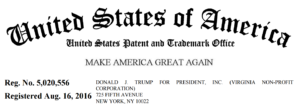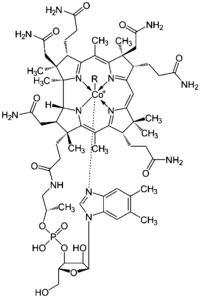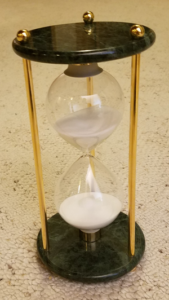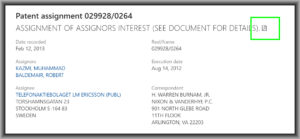The search fee for ISA/JP will increase today for US PCT filers. For a US PCT filer whose PCT application is filed in English, the search fee was previously $1378. Starting today, it will be $1530.

Bluesky: @oppedahl.com
The search fee for ISA/JP will increase today for US PCT filers. For a US PCT filer whose PCT application is filed in English, the search fee was previously $1378. Starting today, it will be $1530.
Readers will recall (see blog articles here and here and here) that in 2015, Donald Trump filed a number of trademark applications for “MAKE AMERICA GREAT AGAIN”. Two are now registered and the other two have Noti ces of Allowance.
ces of Allowance.
Someone has now filed a cancellation petition seeking to cancel one of the registrations (quoted at right).
The Answer is due November 7, 2016, which I note is a day before election day.
 When I was first in practice some thirty years ago, the way that you kept abreast of any and all developments in IP law was … you paid $1000 per year to subscribe to BNA’s PTC Journal. This came out every two weeks, if I recall correctly, and told its readers about rulemakings, important court cases, and other developments. Some years later it became commonplace for professional organizations like AIPLA and the ABA/IPL to send out an email newsletter reporting important events maybe a week after the event occurred.
When I was first in practice some thirty years ago, the way that you kept abreast of any and all developments in IP law was … you paid $1000 per year to subscribe to BNA’s PTC Journal. This came out every two weeks, if I recall correctly, and told its readers about rulemakings, important court cases, and other developments. Some years later it became commonplace for professional organizations like AIPLA and the ABA/IPL to send out an email newsletter reporting important events maybe a week after the event occurred.
How things have changed. Nowadays if I want to know whether something important happened, the way I find out is that one of the IP bloggers blogged about it (see Patently-O and TTABlog and the other bloggers who sponsor “Meet the Bloggers“). Or I learn about it from one or another of the listservs for IP professionals (see some of the listservs here). Or if, like me, you are an adjunct professor on an IP subject, you can benefit from the IP Profs listserv. Generally if something interesting or important has happened, I can be pretty sure that I will hear about it from one of these valuable resources. And I will likely hear about it from one of these resources much sooner than from any of the legacy sources.
Which brings me to today’s posting. Alert listserv member Rick Neifeld posted an article to the PAIR listserv. He wrote:
WIPO is launching a structure search functionality early in October.
By which he means a functionality for searching chemical structures.
Now there have always been resources for searching chemical structures. The ones I have known about over the years were fee-for-service resources from providers such as Orbit and Dialog. I don’t really know but I have to assume that USPTO and the other major patent offices must have always had internal resources for searching chemical structures.
I like to think that I keep on top of many if not most outreach efforts and initiatives from WIPO. And I had never heard that WIPO is launching a structure search functionality, let alone that it would be launched early in October. How did I hear about it? From Rick in the PAIR listserv. Bless his heart he also posted his notes and comments and excerpts from the WIPO presentation slides. You can see them here. It seems that WIPO gave an outreach presentation today, and Rick attended, and later the same day he provided his very helpful notes.
As I understand it from Rick’s notes, this will be an add-on to the existing search functionalities of Patentscope.
Thank you Rick!
Oh by the way, the first poster to correctly identify the chemical in the structure quoted above will receive a piece of swag, namely an official OPLF voltmeter.
Anyone who is relatively new to US patent prosecution will benefit fro m AIPLA’s Patent Prosecution Boot Camp. Now in its eighteenth year, this boot camp offers the opportunity to learn from experienced patent practitioners. From the brochure:
m AIPLA’s Patent Prosecution Boot Camp. Now in its eighteenth year, this boot camp offers the opportunity to learn from experienced patent practitioners. From the brochure:
This two-day seminar, also referred to as “boot camp,” is tailored to new practitioners (those having less than two years of experience), or others who want to learn the basics of patent application preparation and prosecution. This comprehensive CLE-accredited seminar includes instructional sessions, hands-on claim drafting, and responding to office actions workshops taught by highly skilled, experienced private and corporate practitioners. At the program’s conclusion, attendees may choose to participate in one of three hands-on claim drafting and responding to office actions workshops in these areas:
Where: Marriott Wardman Park Hotel, 2660 Woodley Road NW, Washington, DC 20008-4106.
Yours truly will be one of the presenters.
To learn more, or to register, click here.
John Marshall Law School is sponsoring a PCT Seminar on Thursday and Friday, O ctober 20-21, 2016. From the brochure:
ctober 20-21, 2016. From the brochure:
This two-day seminar offers an examination of current practice with regard to the PCT system for patent professionals. A half-day session will focus on an overview of the PCT system, the most recent and future developments in the PCT system as well as covering some of the most important strategic decisions that need to be taken when using the PCT system. This will be followed by a day and a half looking at a detailed analysis of the PCT system, covering best practices and sophisticated tips about the procedural aspects of the PCT. It will cover the process from start to finish including the filing of the applications, preparing the international search, the preliminary examination, and eventually entering the national phase before designated Offices. This course will also offer a platform for the participants to discuss more complex and unusual scenarios and to discuss particularly interesting real-live cases put forth by the instructors or by the attendees’ own experience.
The location is John Marshall Law School, 315 South Plymouth Court, Chicago, IL (map).
The presenters are Matthias Reischle, Deputy Director, PCT Legal Division, WIPO, and yours truly.
To learn more or to register, click here.
We remember those bad old days when DO/EO/US was taking a year and a half to get around to mailing a Filing Receipt in a newly filed entry into the US national phase. The backlog of unattended-to US national-phase filings had gotten so bad that DO/EO/US had to set up a special processing queue for cases in which the applicant had filed a PCT-PPH petition. The idea was that a case deserving of “special” status should not languish for a year or more just because DO/EO/US had fallen so far behind.
Within the past year or two DO/EO/US has managed to be much more prompt about this important task of mailing Filing Receipts. And along with this improvement, DO/EO/US had dropped the special processing queue for cases in which the applicant had filed a PCT-PPH petition.
And indeed in recent months we have seen stretches of time during which many cases were receiving their Filing Receipts a mere two or three weeks after the date that the applicant has perfected the entry into the US national phase.
What’s a bit baffling, however, is to see that there is now more of a spread in the period of delay at DO/EO/US. While a large plurality of cases recently do receive their Filing Receipts promptly (within two or three weeks), an ever-growing fraction of cases sit for some months, untouched by DO/EO/US.
For a case that was not going to get examined any time soon, this is perhaps not a big deal. But for a case in which a Highway petition has been filed, the lack of attention by DO/EO/US goes against USPTO’s policy reasons for supporting the Patent Prosecution Highway in the first place.
What shines a bright light on this is the recent super improvement by the Office of Patent Petitions which, after falling terribly behind, has in recent months done much better in handling of Highway petitions. A year ago it was commonplace to see Highway petitions that had languished for six or seven months untouched by the Office of Patent Petitions. But nowadays the OPP gets kudos for granting Highway petitions in just two to four weeks.
So back to the promptness of DO/EO/US to mail Filing Receipts. As I say, these days a large plurality of cases recently do receive their Filing Receipts promptly (within two or three weeks). But we have cases with granted Highway petitions that still do not have a Filing Receipt despite having the national phase perfected as long ago as May 25 (about four months ago).
One wishes that the managers of DO/EO/US would generate a report from time to time that lists old cases that lack Filing Receipts, and that somebody would try to figure out why the old cases don’t get worked on. Are the laggard cases all assigned to particular laggard workers, for example? I assume that many workers in DO/EO/US work from home. Are the laggard cases all assigned to people who work from home?
I was honored to have an opportunity to play a small role in the planning for Design Day 2016. So I have reviewed the attendee evaluations just now. One of the evaluation questions was “how did you hear about Design Day 2016?” And I am delighted to be able to report that some of the respondents said they heard about it from this very blog, the Ant-Like Persistence blog.
I’ve been getting emails and texts from people asking how it is going in the quest for  a good hourglass.
a good hourglass.
I think I can now declare victory, but it was a long road. Continue reading “Hourglass update”
There is a fundamental problem with customer numbers at the USPTO. It is the problem of trying to fit six pounds of nails into a five-pound bag. The nails don’t fit and the bag gets holes in it.
The original purpose of customer numbers was to provide an easy way to tell the USPTO where to send patent correspondence. The idea being that if a firm had an address change you would only have to update the address once (in the customer number record) and this change would then automatically take effect for all patent files that were associated with that customer number. This was like 24 years ago. Nowadays this is called the “correspondence address” customer number.
Then the USPTO grafted a third limb onto the Frankenstein. The customer number would also be used to keep track of where the maintenance fee branch should mail reminders about unpaid maintenance fees. This is called the “fee address” customer number.
Then the USPTO grafted a fourth limb onto the Frankenstein. The customer number would also be used to define the recognized power of attorney. The idea with this is that the client grants power of attorney not to any particular practitioners but instead to “the practitioners associated with customer number X”. The idea was that if a new practitioner were to join a firm, there would be no need to round up another signature from the client granting power of attorney to the new practitioner. Instead someone would add that new practitioner’s registration number to the customer number, and the client would automatically now be granting power of attorney to that new practitioner. Or if a departing practitioner were to depart from a firm, there would be no need to round up another signature from the client revoking power of attorney to the departing practitioner. Instead someone would delete that new practitioner’s registration number from the customer number, and the client would automatically now no longer be granting power of attorney to that departing practitioner. This is called the “power of attorney” customer number.
So at any given instant a file at the USPTO might have three distinct customer numbers — the CA (correspondence address) CN (customer number), the FA (fee address) CN, and the POA CN. Nothing about USPTO’s computer systems required that these customer numbers be the same. At OPLF we have files where none of the three customer numbers matches either of the other two customer numbers.
Then the USPTO grafted a fifth limb onto the Frankenstein. The USPTO developed Private PAIR, which lets people see stuff that the general public cannot see. How would the USPTO figure out who is permitted to see a particular (otherwise secret) file? The user-friendly thing would be to permit the customer to pick who could see the file and who could not. This could be an “access list” of users each with his or her own password. The “access list” approach could, for example, permit a client to see the file even if the client did not have any registered practitioners on the payroll. But that is not the choice that the USPTO made. The USPTO chose to tie it to a customer number.
Having chosen to use a customer number as the way of determining who would and would not be permitted to see a file, which customer number would USPTO use for this purpose? The POA CN? The CA CN? The FA CN? Or would USPTO add a fourth field to its database, the “PAIR customer number”?
I would have imagined the correct choice to be the POA customer number. If the client trusts someone enough to give them power of attorney, then it makes sense they would get to see an otherwise secret file.
But I imagined wrong. USPTO picked the CA CN as the customer number that would determine who gets to see the file and who does not.
Next USPTO found a sixth limb to graft onto the Frankenstein. USPTO decided to try to migrate away from postal mail as a way to mail stuff to applicants, such as Office Actions, Filing Receipts, and Notices of Allowance. USPTO wanted to simply send an email to the applicant, listing the files in which there was outgoing correspondence. This so-called “Outgoing Correspondence Notification” or OCN would be emailed to whom, exactly? Should USPTO let the applicant (or practitioner) pick what email address or email addresses would be used?
The choice USPTO made was to say that going forward, a customer number would contain not only a list of practitioners, not only a postal mailing address, but also a list of up to three email addresses. And then when the time came for USPTO to send out an OCN by email, USPTO would look to see what is the CA customer number, and then would look to see what are the email addresses for that customer number, and would then send the OCN to those email addresses.
Let’s step back a little bit and ask ourselves how this six-limbed Frankenstein works in practice.
As a first example, consider that every particular CN by definition contains a postal mailing address. But if a particular CN is used for POA purposes, it does not matter at all what exact postal mailing address that is. The postal mailing address in that CN could contain typographical errors or bigger mistakes and it would have no consequence. It would likewise not matter what email addresses were inside that CN, and whether they were spelled correctly or not.
As a second example, consider that every particular CN by definition contains a list of patent practitioners. But if a particular CN is used for CA or FA purposes, it does not matter at all who is in the practitioner list. The practitioner list in that CN could contain random practitioner numbers or only practitioner numbers of deceased practitioners, and it would have no consequence.
There is the story of the frog in the cooking pot that keeps getting hotter, but only slowly hotter, and so the frog never gets the idea to hop out of the pot. Here it is of course understandable that the USPTO could have ended up with the six-armed Frankenstein. Each grafting of another arm onto the Frankenstein is like making the cooking pot just a little hotter.
At some point USPTO needs to hop out of the pot. USPTO needs to get a fresh start on how it accomplishes a variety of things that don’t really need to be linked with each other:
A fresh start would permit selective access to a file, so that for example a client could see their file even though they don’t have a practitioner on the payroll. A fresh start would permit setting it up so that the inventor could see the file. A fresh start would permit role-based selective access, for example so that the client can “look but not touch” while the practitioner can look and also make changes. A fresh start would squarely recognize that not every person at a patent firm (or corporate patent department) is registered to practice before the USPTO. (As things stand now, the USPTO does not really do a good job of accommodating the secretary or paralegal who might have a legitimate reason to log in to Private PAIR.)
The USPTO did a nice thing today. As of today, you can receive a PDF copy of a recorded patent assignment!
can receive a PDF copy of a recorded patent assignment!
Until now, the only way to get a copy of a patent assignment was to place an order with the Order Entry Management System and pay $25. And then wait a couple of weeks for the copy to show up in the mail.
But now, thanks to alert reader Rick Neifeld, I have learned that you can get it for free, and you can get it instantly. The way to make this work requires the user to learn a few steps, but once you learn it, it’s easy.
A first thing to appreciate is that you can’t start with the “assignments” tab of PAIR. You need to go to Assignments on the Web (Patents). Then do a search. You can search on any of the usual things — application number, patent number, whatever. Eventually you will figure out the reel and frame number that you care about. Click on the reel and frame number to get to a page that is specific to your reel and frame number. You will then see a page like the screen shot above (click on the image to see it bigger). Look for a barely visible icon just to the right of the word “details” (marked with a green rectangle), and click on it. What will pop up is a PDF copy of the recordation cover letter and the assignment itself.
This is a welcome development at the USPTO! USPTO deserves kudos for providing this helpful service.